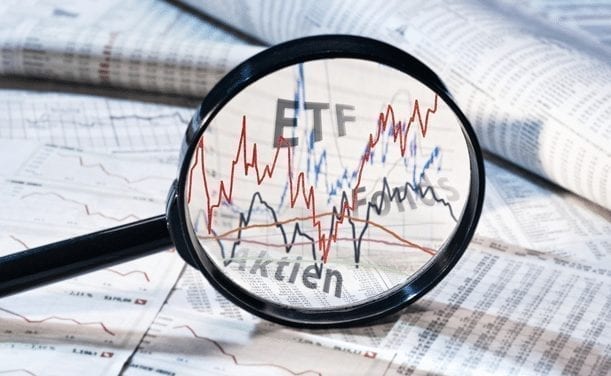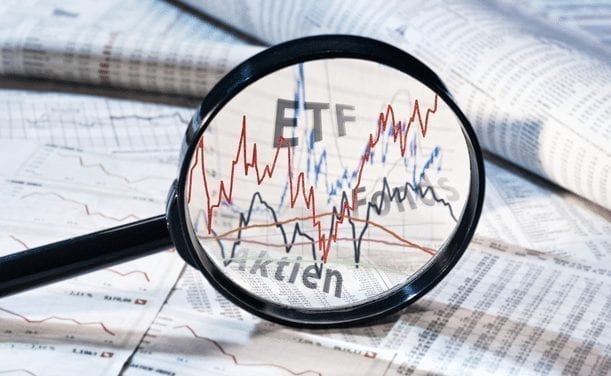Exchange traded funds (ETFs) are similar in many ways to mutual funds, but they are actually traded in a more similar way to equities. They are mainly a basket made up of different securities which are traded similarly to how normal stocks are on an exchange.
YOUR CAPITAL IS AT RISK

Most of the time ETFs will track some sort of underlying index. It is similar to a mutual fund in the way that it is like a mini portfolio. In this article we will cover all the basics of trading ETFs.
Table of contents
- How to trade ETFs
- Key factors to consider when learning how to trade ETFs starting with market liquidity
- What is the approach that retail ETF traders should take when learning how to buy ETFs?
- Making Bigger Trades
- Using limit orders
- Having a strategy for trading ETFs
- Analysing ETFs
- Swing Trading
- Conclusion: How and Why to Trade ETFs
How to trade ETFs
ETFs are a quick and easy way for an investor to get involved in the financial markets without having to make too many complex decisions themselves. Once they have decided what ETF they want to invest in, the rest is out of their hands until they decide to sell their position in a given ETF. To learn how to trade ETFs, you need some basic information to start off with. This basket of securities will normally focus on a given industry, class of asset or some other type of category. They are ideal for quickly creating a portfolio that is diversified, or for more short-term traders they can be used to take advantage of quicker price movements.
As ETFs are similar to stocks, in so far as they are traded on exchanges, you have the ability to short them, once you have the correct type of account with your broker. This means that you can potentially profit on a falling price movement of a given ETF, even if you don’t own a position in it. This is of course a risky move and could be damaging if it doesn’t pay off.

The main difference between mutual funds and ETFs is that there is intraday trading with ETFs. Mutual funds will settle on a single price when the trading day has been completed, which is called net asset value (NAV). ETFs will be traded during the day on exchanges which means that their price will fluctuate depending on the current supply and demands of the market, similar to stocks.
Key factors to consider when learning how to trade ETFs starting with market liquidity
Liquidity: There is a lot of money and activity in the ETF market, with some of the leading funds being extremely popular with investors. This means that you are going to find it a lot easier when trying to make a trade when it comes to the more popular ETFs. There are some funds that are more niched in nature, which will be in markets that are a bit less liquid.
Choices: There are a staggering number of ETFs for you to choose from, covering a wide array of asset classes, including bonds and equities. You will be able to narrow down your ETFs of choice depending on the factors such as geographic area, style of investment, a commodity, sector etc. There are new ETFs being introduced regularly into the market, which come with innovative new approaches and ideas.
Diversity: One way in which traders utilise ETFs, is to get involved in markets that they wouldn’t normally invest in. This is thanks to there being baskets of stocks, rather than having to purchase individual stocks, which of course won’t be diversified like a usual portfolio will.
What is the approach that retail ETF traders should take when learning how to buy ETFs?
When discussing the trading of ETFs and how to buy ETF shares, there are two types of trades you are going to be dealing with. If you are a retail investor and you will likely be making relatively small purchases, therefore, you will be trading ETFs in a similar fashion to normal stock trading. You will be able to see the bid/ ask prices through your given trading platform. For those who will be doing some more sizeable trading, it is a different process. This article presumes that you are going to be a retail trader who will not be dealing with institution-sized money with your ETF trading.
On the most basic level when learning how to buy an ETF, you will be dealing with market orders. While they are a simple way of placing ETF trades, they also add risks to trading ETFs. When you go to place your market order, this gives instructions to your broker that you want this ETF traded immediately, no matter what price it may be. For example, if the current market offering for your chosen ETF is £59.90 for the bid and £60.10 for the ask and you are looking to make a purchase of a small number of ETF shares, it is likely that your order will be filled at the £60.10 point.
Making Bigger Trades
If you are going to be making trades that are larger in size, there is not a guarantee that the market order will be executed on the spread that is currently publicly available. The spread that you are seeing through your trading platform is simply what the best bid and offer is at that moment in time, but it may just be for 10 or 100 shares. If you are looking to purchase a larger number of shares, your order is going to be filled at a higher price than the figure which you have seen on the broker platform.
There are also a number of ETFs that have wider spreads. For those ETFs, which are less liquid, there could be a spread maybe 5% or even 10%, which is a massive price to pay. Rather than dealing with market orders, you can get a more attractive price when using a straightforward limit order (see below). Finally, there can be significant swings in the market between the time you have placed your market order and by the time it gets executed. As a general rule of thumb, you are best off using market order for the most liquid and biggest ETFs where you will be pretty much guaranteed to have instant execution. Otherwise, you should avoid using them as part of your trading.
Using limit orders
The next step up from using a market order is that of the limit order. The limit order is when the trader instructs the broker what the maximum price you are happy to pay when buying a given ETF will be, or when you are selling, what the lowest price you are willing to sell at. This means that you will give yourself protection against poor price execution. If the market begins to turn away from the direction of your order, however, your order won’t get filled. Traders often utilise limit orders when trying to get an execution that lies in between the given spread. If you are patient, you will likely get your order filled very close to the bid price, potentially giving you noteworthy, long term savings when dealing in significant quantities of shares. You are, therefore, much better off using a limit order as opposed to a market order in many scenarios.
The final option that is used when trading ETFs is usually reserved for traders dealing with significantly large trades. They can do business with liquidity providers. These are institutional-type market makers that have the aim of facilitating the buying and selling process of ETFs for traders. They effectively are facilitators for the ETF market.

Having a strategy for trading ETFs
Just like with all trading and investing, you need to have a comprehensive strategy in place that has been tried and tested over a significant period of time. You can then place your trust in your plan, while tweaking according to the experiences you have when trading ETFs. The types of analysis traders and investors use will be often be fundamental or technical analysis. Technical analysis relies on charts and statistics resulting from the activity of the market, including variables such as volume and previous prices.
Fundamental analysis relies more on looking at significant economic events, such as the release of data, central bank activity, financial reports for companies and geopolitical events that impact the market. A lot of traders will use a combination of these approaches in order to come to a conclusion about a given trade. The type of strategy you use depends on what type of ETF you are focusing on. If you are focusing on a specific corporate bond ETF for example, you will mostly be using fundamental research, looking at the earnings for the company, as well as their credit rating, plus looking at the economic outlook for the given industry.
Analysing ETFs
If you are analysing an ETF which tracks a major stock index, this will possibly lead to more emphasis on technical analysis, while also still looking at how certain changes in the economy could affect the fortunes of the ETF performance.
Overall, ETFs are great investment and trading vehicles for investors and traders, because of the significant liquidity, low expense ratios, large choice and low entry costs. Dollar cost averaging is a popular strategy for ETF trading. This is when you invest the same dollar amount on scheduled intervals, no matter what the price of the ETF may be. This is easy to do because it doesn’t require any research or effort after the initial decision making on which ETF to purchase. It is a common way in which young people save their money and as you are investing consistently every month, therefore, the price you pay overall for the given ETF will average out over time. A lot of people use ETF trading to work on their asset allocation depending on the mood of the market. For example, if there is high volatility, they will favour lower volatility ETFs that focus on stocks which do not have as much volatility, as well as those holding significant amounts of bonds and cash etc.
Swing Trading
Swing trading is used in order to take advantage of significant price swings in the price of a stock or other security. This could have a time interval of anywhere from a few days to a few months. ETFs are an ideal choice for swing trading because they have narrow bid/ ask spreads, as well as being easily diversified.
ETFs are an easy way in which you can short a specific sector or region. While betting against the success of a company, industry etc. is risky and there is potentially a sizable downside, this strategy is commonly used by ETF traders when they believe that a given market is going to decline. A lot of ETF traders use the market in order to try to profit from seasonal trends. Certain markets tend to work in trends depending on the time of year. Traders will invest in an ETF before the trend begins and ride it out for a while as the price hopefully increases and then close out this position before the seasonal trend ends.
Conclusion: How and Why to Trade ETFs
ETFs are a useful way for traders to hedge their positions. There is such variety and choice available in the ETF market that it is not hard in most cases to find a suitable ETF which will help a trader to hedge another position they may have open.
As you can see, the ETF market is very popular for both beginners and experienced traders alike. There is so much flexibility and many great options for you to make profitable investments that it is an appropriate place to trade. It is easy to diversify and have liquidity in the majority of casecs.
It is important that you continually develop your skills and expertise across a variety of ETF trading strategies and ensure that you learn from both your successes and failures when trading the market. If you do so, you can certainly have a profitable experience trading ETFs.













